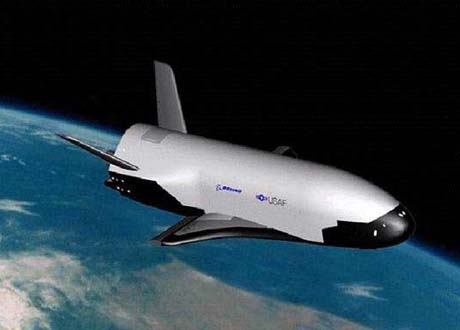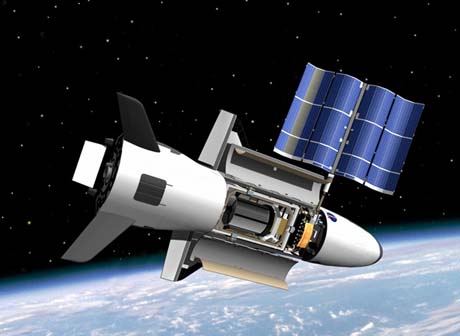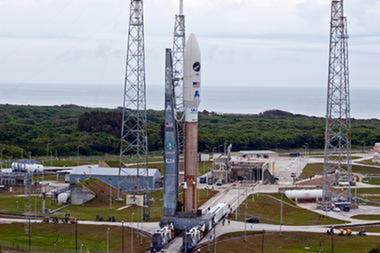
2010 04 24
By Gordon Lubold | YahooNews.com
Clear, sunny skies are forecast for Cape Canaveral Wednesday, perfect weather for the launch of a new unmanned spacecraft and the dawn of an era. Just don’t expect the Air Force to tell you what that new era is.For the first time, the service will launch the X-37B Orbital Test Vehicle, a brand new, unmanned spacecraft to demonstrate the military’s ability to fly into space, circle the globe for months on end, and return intact, only to fly again.

Now being readied for an orbital shakeout, the X-37B (shown here in an illustration) is an unpiloted military space plane. Launched from Florida, the vehicle will make an auto-touchdown in California. Credit: USAF
But whether the X-37 space plane is merely showing off nearly two decades of research and development or is actually a precursor to militarizing the final frontier, is far from clear since the vehicle’s payload is classified. An Air Force official won’t even say when it will return to California or where it will land. But it can "loiter" over the globe for more than nine months.
"In all honesty, we don’t know when it’s coming back," said Gary Payton, deputy undersecretary for the Air Force’s space programs, in a conference call with reporters Tuesday.

NASA’s Marshall Space Flight Center image shows on-orbit functions for the reusable X-37 space plane, now under the wing of the U.S. Air Force. Credit: NASA/MSFC.
’Weaponization’ of space?
Arms control advocates say it is pretty clearly the beginning of a "weaponization of space" – precursor to a precision global strike capability that would allow the US to hover for months at a time over anywhere it chose with little anyone could do about it.
"The idea of being able to launch an unmanned research platform that can stay up there for months on end provides you with all kinds of capability, both military and civilian," says Chris Hellman, a policy analyst with the National Priorities Project, a budget watchdog in Northampton, Mass.
He believes the fact that it is an Air Force initiative may say something about what it will ultimately used to do. And that may not sit well with others. "I can see where the prospect of having half a dozen of these things with unknown payloads circling overhead could be very troubling to people," Mr. Hellman says.

An Air Force official today said the X-37B space plane should not be considered a weapon. In this photo, the X-37B space plane sits in its capsule atop an Atlas V rocket as it makes its way to the launch pad at Cape Canaveral, Fla. The rocket launched Thursday night. United Launch Alliance
What the Air Force will say is that the X-37 will demonstrate "various experiments" and allow "satellite sensors, subsystems, components, and associated technology" to be transported into space and back. Officials say the vehicle could change the way the service operates by making space operations more "aircraft like" with a vehicle like the X-37 able to take off and later land and then fly again.
When it returns, scientists will determine how many of its components survived the flight and how long it will take to get the craft back into the air. The shorter the turnaround time, the better, since that would mean fewer X-37s would have to be built, regardless of its ultimate mission.
If it takes a long time to get the bird back in the air, "it will make this vehicle less attractive to us in the future," Mr. Payton said.
Many unknowns, including ultimate mission
Still, there are many unknowns. And analysts who typically know about such things are left to shrug.
"There does not seem to be a publicly acknowledged capability that this thing will lead to," says John Pike, director of globalsecurity.org, a national security research organization in Alexandria, Va. "If taken at face value, it seems to be simply to satisfy the idle curiosity of the scientific community."
Mr. Pike believes one of the inherent values of the X-37 could be as a maneuverable satellite which could be used to look over China’s shoulder one day, yet evade any attempts to shoot it down.
On the other hand, says Pike, it could amount to nothing more than "recreational engineering," borrowing a term from the magazine Scientific American. "What’s a few hundred million dollars between friends?"
Whatever it is or represents, the Air Force likes it. Air Force officials say they are already building another X-37 spacecraft that it hopes to fly by 2011.
Article from: news.yahoo.com
Air Force says X37-B space plane is not a weapon
By Tariq Malik | CSMonitor.com
[...] The unmanned X-37B space plane, now known as the Orbital Test Vehicle 1, actually began its life as a civilian project founded by NASA in 1999 to test landing and other spacecraft technologies. NASA turned the program over to the Defense Advanced Research Projects Agency (DARPA) in 2004. The Air Force took control of the project in 2006.
Space policy analyst Joan Johnson-Freese, professor of National Security Studies at the Naval War College in Newport, RI, has told SPACE.com that the X-37B could either be a major advancement in human spaceflight or be the unmanned end result of the Air Force’s dream of building a crewed space plane.
"In any case, it is likely that other countries will see it as another capability intended to assure the United States will be able to dominate access to and the use of space," she said in an earlier interview.
Spaceship or weapon?
Payton said that the X-37B launch is primarily aimed at testing fundamental technologies for reusable spacecraft and space applications.
"If these technologies on the vehicle prove to be as good as we estimate, it will make our access to space more responsive, perhaps cheaper, and push us in the vector toward being able to react to warfighter needs more quickly," Payton said.
But it is the spacecraft’s appearance as a rapid-response vehicle that can be launched on unmanned rockets has led to some speculation of its potential as a space weapon.
"Regardless of its original intent, the most obvious and formidable [potential use] is in service as a space fighter - a remotely piloted craft capable of disabling multiple satellites in orbit on a single mission and staying on orbit for months to engage newly orbited platforms," comparative military studies professor Everett Dolman, if the School of Advanced Air and Space Studies at the Maxwell-Gunter Air Force Base in Montgomery, Ala., has told SPACE.com. That capability "would be a tremendous tactical advantage."
Dolman said it’s still too early to determine what the ultimate use for the X-37B, or any future successors, may be.
The X-37B Orbital Test Vehicle 1 was built by Boeing in Seal Beach, Calif., and weighs about 11,000 pounds (about 5,000 kg). This SPACE.com X-37B graphic illustrates some details of the space plane and its relative size.
Mini-shuttle in space
Air Force officials have said the X-37B will be tested as a "flexible space test platform to conduct various experiments and allow satellite sensors, subsystems, components and associated technology to be efficiently transported to and from the space environment."
The space plane’s payload bay can fit a couple of small satellites to be launched and deployed, but it does not have a robotic arm to grapple objects in space and retrieve them. That means it could be used to support military operations oversees by rapidly deploying space-based assets like small communications or reconnaissance satellites.
"This launch helps ensure that our warfighters will be provided the capabilities they need in the future," said Air Force Col. Andre Lovett, 45th Space Wing vice commander, Launch Decision Authority for the mission, after the launch.
The X-37B Orbital Test Vehicle also has a long loiter time in space. It has a solar array tucked in its payload bay that can keep it powered up for around 270 days, Air Force officials have said.
"We, the Air Force, have suite of military missions in space and this new vehicle could potentially help us do those missions better," Payton said.
Payton has said he envisions the X-37B has functioning much like the SR-71 Blackbird spy aircraft, being on alert in times of need to fly a mission that could support military operations. The time between flights, during a rush period of many space launches, could be as little as 10 to 15 days, Payton said.
It is still unknown how long the first X-37B will remain in orbit. But when it returns, it is expected to autonomously fly itself through the Earth’s atmosphere and land at Vandenberg Air Force Base in California, with Edwards Air Force Base as a backup.
Article from: CSMonitor.com
Video from: YouTube.com
"A United Launch Alliance Atlas V rocket launched the Air Force’s Orbital Test Vehicle, X-37B OTV-1, from Cape Canaveral Air Force Station. This video was taken from the NASA KSC press site facility on top of the CBS building, about 4 miles from the launch pad. The liftoff and ascent were spectacular, just after sunset."
Video from: YouTube.com
Video from: YouTube.com
[Ed Note: The Pentagon Channel?!? Find it here]
Also tune into:
Freeman - Space War, the Norway Spiral, CARE, CERN, HAARP & EISCAT
Freeman - Obama, Cloning & The Coming Space War
Alfred Webre - Exopolitics, NASA Bombing of the Moon, Outer Space Treaty & E.T.
Kathleen McErlain - Too Many Secrets, Humanity’s Fight to Expose The Secret Underground Worlds
Mike Bara - Dark Mission, The Occult NASA Moon Mission
Ted Twietmeyer - What NASA isn’t Telling you about Mars
Stewart Swerdlow - Montauk Project & Mind-Control
Stewart Swerdlow - The Illuminati & The Alien Agenda
Joseph P Farrell - Cosmic War, Interplanetary Warfare & Mesopotamian Mythology
Andrew Collins - The Cygnus Mystery
Marko Rodin - Vortex Based Mathematics
Red Ice Creations
Hey,Thanks for videos and information,I have seen many post on this topic.
AntwortenLöschen